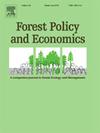Preliminary evidence of softwood shortage and hardwood availability in EU regions: A spatial analysis using the European Forest Industry Database
IF 4
2区 农林科学
Q1 ECONOMICS
引用次数: 0
Abstract
As the overall demand for wood-based products continues to grow, questions arise on how local wood resources and industry characteristics can effectively meet this growing demand. In the European Union (EU) 550 million m3 of wood is harvested annually, and is to a large extent processed by the wood industry. Little is known about the interplay between industrial capacity and the regional availability of timber resources. We compared the capacities from the European Forest Industry Facilities Database (EUFID) with the estimated wood supply from the procurement areas around processing industries, calculated using a spatially explicit resource model (EFISCEN-Space). We found that the estimated total capacity for the available European countries is 427 M m3 roundwood equivalent (rw. Eq.) for pulp and paper (including both virgin and recycled fibres), 102 M m3 for bioenergy (only bioenergy plants), and 153 M m3 for sawmills. We then conducted an in-depth analysis of three case studies: Norway, the Czech Republic, and Germany. Given the current probability of trees being harvested (excluding disturbances) and the hypothetical optimal grading of the logs, the volume for each assortment type is closely aligned with the current capacity of each industry branch, indicating no overcapacity. We found undersupply of softwood of 3.4 M m3 for the Czech Republic, 1.5 M m3 for Norway, and 3.8 M m3 for Germany. At the same time, in Germany, we found an oversupply of hardwood of 3.0 M m3. Additionally, a substantial amount of biomass graded as bioenergy was found for Germany and the Czech Republic, potentially serving as fuelwood in households. Concerning wood procurement areas, we concluded that a fixed radius of 100 km from the facility limited the availability of raw material procurement, particularly for bioenergy and pulp and paper mills, suggesting that these two product chains use a broader procurement basin than sawlogs. This study provides a high-resolution, spatially explicit modelling methodology for assessing the interaction between potential wood harvest and industrial processing capacity, which can support projections of sustainable development of the forest industry.
欧盟地区软木短缺和硬木供应的初步证据:利用欧洲林业数据库进行空间分析
随着对人造板产品总体需求的持续增长,人们对当地木材资源和工业特点如何有效满足这一日益增长的需求产生了疑问。在欧盟,每年有 5.5 亿立方米的木材被采伐,并在很大程度上由木材工业进行加工。人们对工业能力与地区木材资源可用性之间的相互作用知之甚少。我们将欧洲森林工业设施数据库(EUFID)中的产能与加工工业周围采购区的估计木材供应量进行了比较,后者是使用空间显式资源模型(EFISCEN-Space)计算得出的。我们发现,现有欧洲国家纸浆和造纸(包括原生纤维和回收纤维)的估计总产能为 4.27 亿立方米圆木当量(rw. Eq.),生物能源(仅生物能源工厂)为 1.02 亿立方米,锯木厂为 1.53 亿立方米。随后,我们对三个案例进行了深入分析:挪威、捷克共和国和德国。考虑到当前树木被采伐的概率(不包括干扰)和原木的假定最佳分级,每种分类类型的产量都与每个行业分支的当前产能密切相关,表明不会出现产能过剩。我们发现,捷克共和国的软木供不应求量为 340 万立方米,挪威为 150 万立方米,德国为 380 万立方米。同时,在德国,我们发现硬木供过于求,达到 300 万立方米。此外,我们还在德国和捷克共和国发现了大量被分级为生物能源的生物质,这些生物质有可能成为家庭的薪材。关于木材采购区域,我们得出的结论是,距离设施 100 公里的固定半径限制了原材料采购的可用性,尤其是对生物能源和纸浆造纸厂而言,这表明这两种产品链使用的采购流域比锯材更广。这项研究提供了一种高分辨率、空间明确的建模方法,用于评估潜在木材采伐量与工业加工能力之间的相互作用,从而为预测森林工业的可持续发展提供支持。
本文章由计算机程序翻译,如有差异,请以英文原文为准。
求助全文
约1分钟内获得全文
求助全文
来源期刊

Forest Policy and Economics
农林科学-林学
CiteScore
9.00
自引率
7.50%
发文量
148
审稿时长
21.9 weeks
期刊介绍:
Forest Policy and Economics is a leading scientific journal that publishes peer-reviewed policy and economics research relating to forests, forested landscapes, forest-related industries, and other forest-relevant land uses. It also welcomes contributions from other social sciences and humanities perspectives that make clear theoretical, conceptual and methodological contributions to the existing state-of-the-art literature on forests and related land use systems. These disciplines include, but are not limited to, sociology, anthropology, human geography, history, jurisprudence, planning, development studies, and psychology research on forests. Forest Policy and Economics is global in scope and publishes multiple article types of high scientific standard. Acceptance for publication is subject to a double-blind peer-review process.
 求助内容:
求助内容: 应助结果提醒方式:
应助结果提醒方式:


